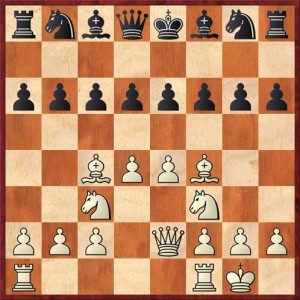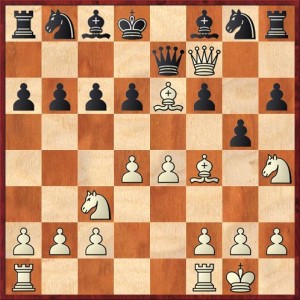Yesterday I was thinking over possible lessons for my kids at the Aptos Library Chess Club, and I thought, “Why not ask them about this position?”
 White to move.
White to move.
FEN:rnbqkbnr/8/pppppppp/8/2BPPB2/2N2N2/PPP1QPPP/R4RK1 w kq – 0 1
This is not a position any readers of this blog will ever see in a tournament game, but it’s something that could very easily arise in a kids’ game.
White has learned to develop all of his pieces, castle, and control the center, just as I taught him. I have at various times described this very setup, with the knights on c3 and f3 and the bishops on c4 and f4, as an ideal setup for White.
Black, like a lot of my students, doesn’t believe in development. Instead he just likes to push all of his pawns one square and shuffle his pieces behind them.
I’d like you to take a little time and think about the position. I don’t even know what the right move is for White. I’m not sure there is a “right” move. How would you decide? Does White have an advantage? How big do you think it is?
Here are some possible thought processes. Some of them contradict each other. Which do you agree with most?
Player 1. Black’s play is so far beyond the pale that he must be punished. I have six pieces developed and he has none. I should find where his weaknesses are and attack them, and sac, sac, mate! Just the way that Morphy would. I’ll start out with 1. Nh4, which attacks the vulnerable g-pawn, and maybe I’ll sucker him into playing 1. … g5, after which I have 2. Qh5+ and he’s got to be dead.
Player 2. Black’s play is so far beyond the pale that he must be punished. I have six pieces developed and he has none. Under these circumstances, what I have to do is blast open some lines. I’ll start with 1. e5, and maybe I’ll sucker him into playing 1. … d5, after which I’ll sac a piece with 2. ef dc 3. Qe4, and he has no way of defending g6.
Player 3. Black’s play is bad because my teacher says so. I’ll just keep doing what my chess teacher tells me. I’ll centralize my rooks with Rad1 and Rfe1 and see what my opponent does next. It would be wrong to launch an immediate attack with 1. Nh4 (because knights on the rim are dim) or 1. e5 because, as Jesse Kraai would say, I need to invite all my pieces to the party.
Player 4. Black’s play is not so unsound that he should be lost. He has one weakness, the pawn on g6, but one weakness should not be enough to lose the game. Also, White’s play has been far from optimal. It’s true that White would like to bust open the center with e5 or d5, but on either of these moves Black is able to trade and then push his own pawn to d5 or e5, respectively. Then the center will be closed, one of my bishops will be blocked and the other one will be under attack. I have to acknowledge that my bishops are badly placed and start looking for better places for them. I’ll start with 1. Bd3, which also has the benefit that it eyes his weak point on g6. I’m not playing for an immediate win, just a slight advantage.
Player 5. I agree with Player 4, except that I think White should be building toward a kingside assault. Therefore I will play 1. Be3 with the idea of following up with Nd2 (or Nh4 if allowed) and f4. I’m not playing for an immediate win, but I do think White has a significant advantage.
Which player is you? Or do you have a completely different viewpoint?
My first instinct is to agree with Player 1. If I were playing in a speed game or against someone I suspected was a beginner (a likely suspicion, given Black’s first eight moves), I would play 1. Nh4 with little hesitation. I expected this to be a simple, Morphy-esque win for White, but it’s not. Even the seemingly foolish reply 1. … g5?! is far from clear. After 2. Qh5+ Kd7 3. Qf7+ Qe7! 4. Bxe6+ Kd8! White suddenly has problems.
 Position after 4. … Kd8. White to move.
Position after 4. … Kd8. White to move.
FEN: rnbk1bnr/4qQ2/ppppBp1p/6p1/3PPB1N/2N5/PPP2PPP/R4RK1 w – – 0 5
White has three pieces hanging (!) and the queens are about to come off the board, greatly reducing his attacking chances. In fact, the only decent move here is 5. Ng6! Bxe6 6. Qxf8+ Qxf8 7. Nxf8, but after 7. … Bf7 8. Bxd6 Ne7 White’s knight on f8 is trapped! According to Rybka White gets more than enough compensation after 9. f4 Rxf8 10. fg fg 11. Rf6, in all likelihood winning a third pawn for the piece, but admit it — this isn’t the walk in the park that you thought it was going to be.
And we haven’t even gotten yet to Black’s best response to 1. Nh4, the developing move 1. … Ne7.
After looking at these lines, I have to admit that White’s flailing efforts to sac material and win in Morphy-esque fashion just don’t work very well. And they involve a lot of calculation, so I’ll probably lose the game on time. So I think that Players 1 and 2 whom I would call the Romantics, aren’t quite right.
Player 3 is someone I would call the Robot or perhaps the Cookbook Player. He isn’t really thinking about the position and is postponing the real issue, which is what to do about the misplaced bishops. It’s not that 1. Rad1 is wrong, but you’re going to have to deal with the bishops sooner or later.
As I analyzed the position I gradually gravitated to the point of view of Players 4 and 5, and probably Player 5 most of all. Rybka prefers Player 4’s move, 1. Bd3, but I’m not quite sure what the plan behind it is. I like the idea of clearing the pieces out of the way of the f-pawn (with 1. Be3 and 2. Nd2) and charging, because it’s a plan that retains some of the blood-lust of players 1 or 2.
Most of all, I wish we could go back a couple moves and not develop our bishops to c4 and f4! That was White’s real mistake.
Interestingly, Rybka initially evaluates White’s position as +1.5 pawns or better — basically winning — but in all lines I’ve looked at, that advantage melts away. After a few moves it tends to drop to about 0.75, which I think is right. White has a significant advantage but it would be wrong to think that the game is over.



{ 3 comments… read them below or add one }
I’ve learned through experience not to give in to the feeling “In this position I really should be finishing off this guy in just a few more moves.”
d5 and e5 are the two moves white really wants to play but isn’t quite ready yet because we need a follow up with either c4 or f4. That’s the reason I think Nh5 may be the best move; it’s not so much that it attacks g6 but that it starts to get out of the way of the f pawn advance. If black just defends his g6 pawn (presumably with Ne7 although Kf7 can also be played), White has all the time in the world to re-route his knight on f3 and then play f4 in a move or two.
Great thought experiment.
I actually played a game like this in 1989 against Robert Sferra. He pushed all of his pawns to the third rank, except the h7-pawn. It was very hard to make progress and I got short of time trying to figure out what to do.
Here’s a link to the game:
http://www.cob.sjsu.edu/splane_m/chess/OddGames.htm